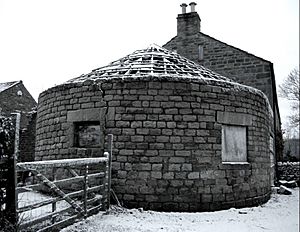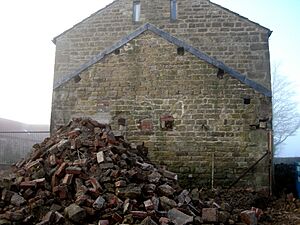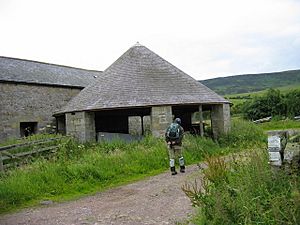Gin gang facts for kids

A gin gang (also called a wheelhouse or roundhouse) was a special building on a farm. It held a "horse engine," which was a machine powered by a horse. These buildings were usually round, but could also be square or octagonal. They were always attached to a threshing barn.
Most gin gangs were built in England between the late 1700s and early 1800s. Inside, a horse would walk in a circle, turning wooden gears and drive shafts. This power was then sent to a small threshing machine in the barn, which helped farmers separate grain from its stalks.
Contents
How a Gin Gang Worked
The word gin here means "engine," and gang refers to the horse "going" or walking. So, a gin gang was where the horse engine worked!
The gin gang was always connected to the main threshing barn. It usually had just one floor. There was a hole in the wall for a drive shaft or belt to pass through, linking the horse engine to the threshing machine.
Inside the gin gang, cogs connected to a tall, vertical pole. A long arm was attached to this pole, and a horse was hitched to the arm. As the horse walked in a circle, it turned the pole and the gears, powering the machine. This setup was very useful in places where there wasn't enough water to power a water wheel.
Gin gangs were built using materials found nearby. This is why they looked different depending on the area. For example, some had thatched roofs in Sussex, while others had pantiles in North Yorkshire or stone tiles in Northumberland. The main purpose of the gin gang was to protect the wooden gears of the engine, not necessarily the horse. In some places, farmers used "horse-walks," which were open-air horse-powered machines without a building.
History of Gin Gangs
Gin gangs had many local names, like covered gin-house, round-house, or horse-mill. In Scotland, Wales, and Warwickshire, they were often called horse engine houses.
Around 1,300 gin gangs were found in Great Britain in 1976, and a few more in other European countries. Most were built between 1785 and 1851, with the busiest time being from 1800 to 1830.
In the 1800s, there were many gin gangs, especially in northern England. However, between the 1890s and 1960s, hundreds were torn down. By the 1970s, most remaining gin gangs were in the north-east and south-west of England. The invention of the portable engine around 1840 meant that farmers no longer needed to build these large, permanent structures.
Where to See Gin Gangs Today
Today, no gin gangs are used for farming. The ones that still exist are either old ruins or have been turned into homes or holiday cottages. Some have been saved and restored in museums.
For example, the Beamish Museum in County Durham has a restored gin gang. Another one is preserved at the Weald and Downland Open Air Museum. These museums help us understand how farmers used to work before modern machinery.
Beamish Museum Gin Gang
The Beamish Museum has an early 1800s gin gang. It has stone walls and a slate roof. The horse mill inside the Beamish gin gang hasn't been used since the 1830s. The museum brought this specific mill from another farm and put it back together as an exhibit. It helps visitors see how these old machines worked.
-
A large wooden drive shaft from the mill passes through the wall into the threshing barn.
See also
- Horse mill
- List of horse mills
- Threshing machine







